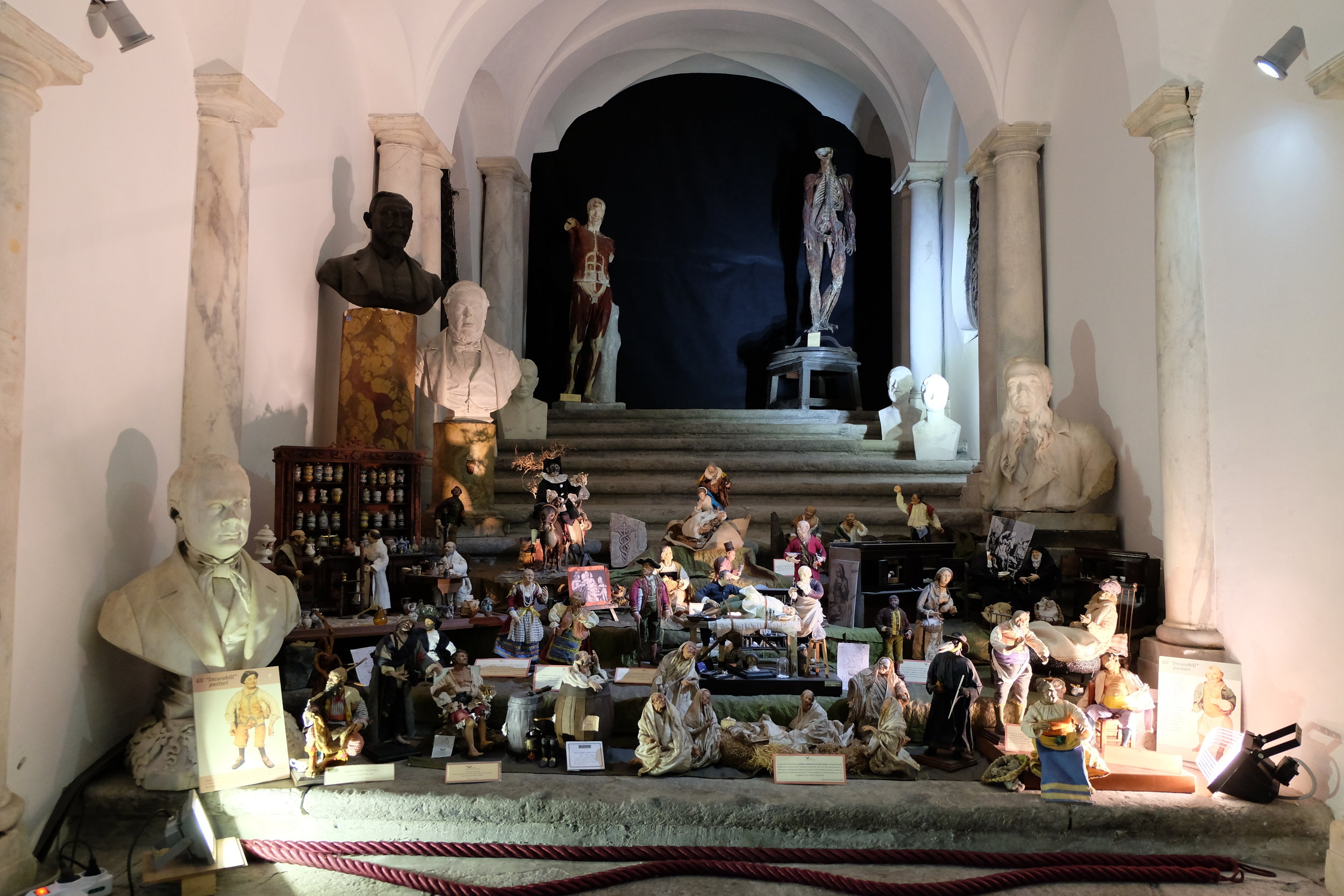Pharmacy of the Incurabili - Farmacia degli Incurabili
Façade of the Pharmacy of the Incurabili located in the courtyard of the hospital. Still standing before the entrance are the marble baths where the sick were washed before entering the hospital.
Entrance to the Incurabili hospital courtyard, where the pharmacy is located.
Not far from the Archeological Museum, in piazza Cavour, there is the Pharmacy of the Incurabili. This is a unique place to visit, as it is not a normal museum. It is much more. Standing in the grounds of a still working hospital, it's a historical pharmacy, a church, a cloister and a library. The Pharmacy is part of the convent of Santa Chiara degli Incurabili (lit. incurable), which was founded between 1520 and 1522 by the Catalan noble woman Maria Lorenza Longo, who dedicated herself to helping the poor and sick. In those years Napoli was struck by the plague and other infectious diseases, that is why in those years so many religious orders and members of the Neapolitan nobility tried to give comfort and help to the population of Naples, opening new convents and hospitals.
During the seventeenth century the complex of the Incurabili was subjected to many enlargements thanks to ever increasing donations. Many important works were made from 1729 by the architect Domenico Antonio Vaccaro, who was also active in other buildings in Napoli. The new space of the pharmacy was divided into two halls, a laboratory and a reception room. The walls of the rooms are covered by six-tier walnut cabinets and the floors are tiled in majolica and terracotta. Every section has shelves containing polychrome vases (originally 480 and dated 1747-48) portraying biblical scenes. These vases are preserved perfectly and contain ointments, syrups and powder.
The large cabinets housing the majolica jars.
The Pharmacy ceiling is decorated with the fresco by Pietro Bardellino depicting scenes from the Trojan War. For many centuries, medicine was considered a witchcraft, with many obscure remedies and sinister ritual. The Pharmacy still contains some mystery in the architecture, like the hidden figures and symbols in marble on the decorations of the doors, architraves and columns. It was believed at the time the those symbols were Masonic symbols.
Masonic symbols at the top of the entrance doors. Almost like marking a line between the known and unknown world of medicine.
Detail of the sculpture at the entrance of the pharmacy, representing the 'virgin uterus' (opposite to the sculpture of the 'post-operative uterus')
Some of the little jars containing remedies for the hospital patients.
Inside the courtyard of the hospital, opposite the Pharmacy, there is the Museum of the history of Medicine and Health. it documents the development and discoveries of medicine throughout the centuries. Indeed, it shows how advanced the medicine in Naples was in the 16th century compared to the rest of the world at the time. The museum houses many rare surgical instruments and artefacts, like a portable pharmacy from the 18th century, the first glass feeding bottles and primitive face masks.
The beautiful camphor tree, planted in 1525. Plants and trees were used to cure diseases inside the yard of the hospital. Here there was also the maternity department, where prostitutes, young women used to come here and give birth assisted by nuns and midwifes.
Entrance to the Medicine Museum.
Some of the medical instruments.
Medicine and powders.
Barbers were also considered doctors. These are some of their tools used for medicine purposes.
The rooms of the Museum show artefacts from the history of Medicine.
Use your imagination to guess what these were used for.
In the museum you can also find one of the most detailed cast's of the human body, dated 1730-40. This model was used by medical students and it shows perfectly the veins, backbones and muscles, and it could also be dismantled and articulated. Also interesting are the masks of the plague doctors. It looks like a beak of a bird, but its purpose was for the doctor to knock at doors without touching them when he was visiting a family affected by the plague.
Presepe display of doctors and in the background, the model of the human body.
How to cure a headache.
Doctors and monks.
Here are represented nuns who looked after children in the maternity rooms.
Doctor during the plague.
The plague doctor with the mask.
Frescoes of the hospital courtyard.
Fresco detail, with nature and masonic symbols.
Official website: .museoartisanitarie.it
Via Maria Longo 50 - 80138 Napoli
Tel.: +39 081 440 647
Email: info@ilfarodippocrate.it
Opening hours: Museum, Mon - Tue and Thursday 09.00 - 13.00 / Pharmacy, Wed, Fri and Sat 09.00 - 17.00.
Nearest metro station: Linea 1 - MUSEO





















